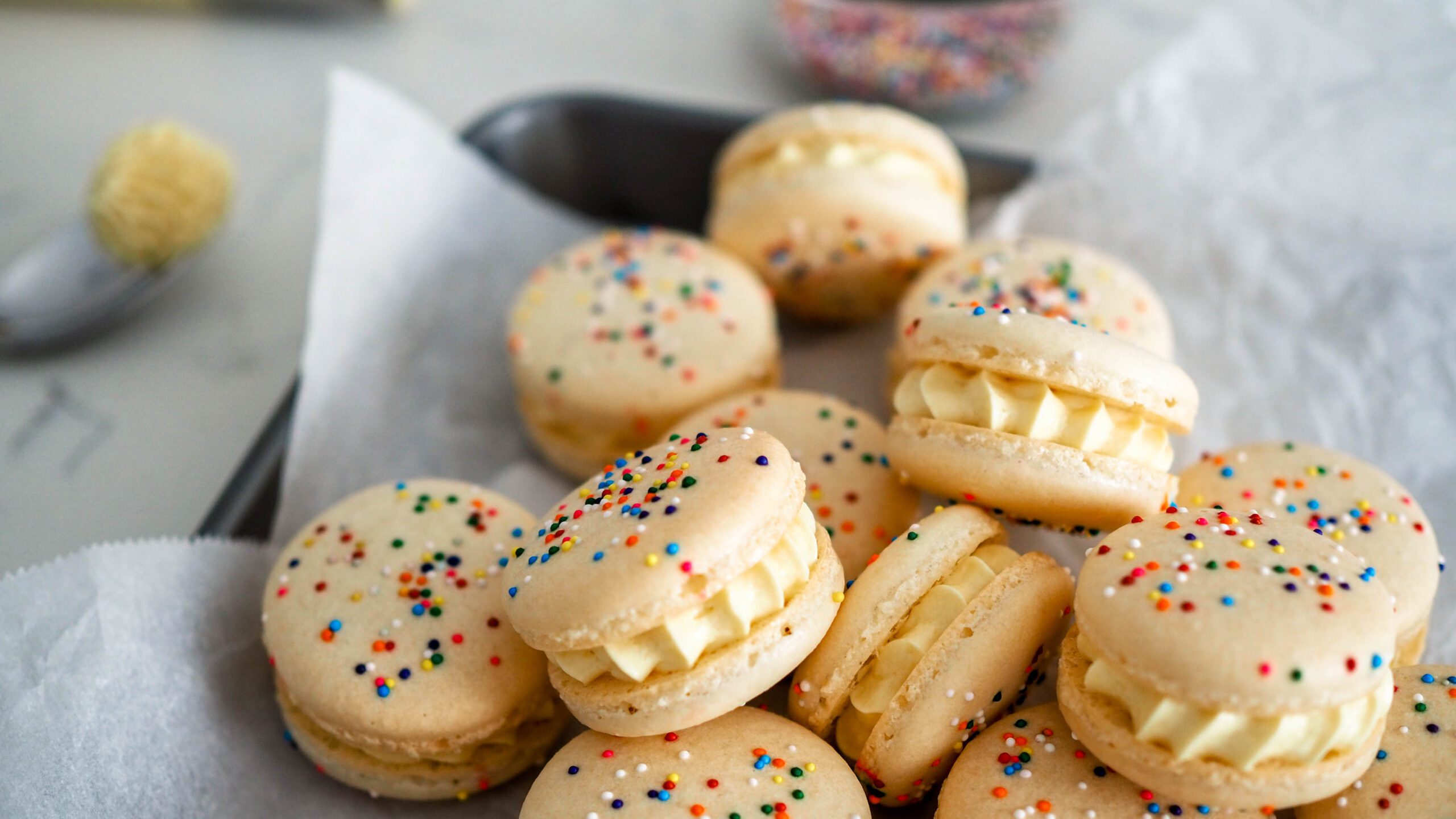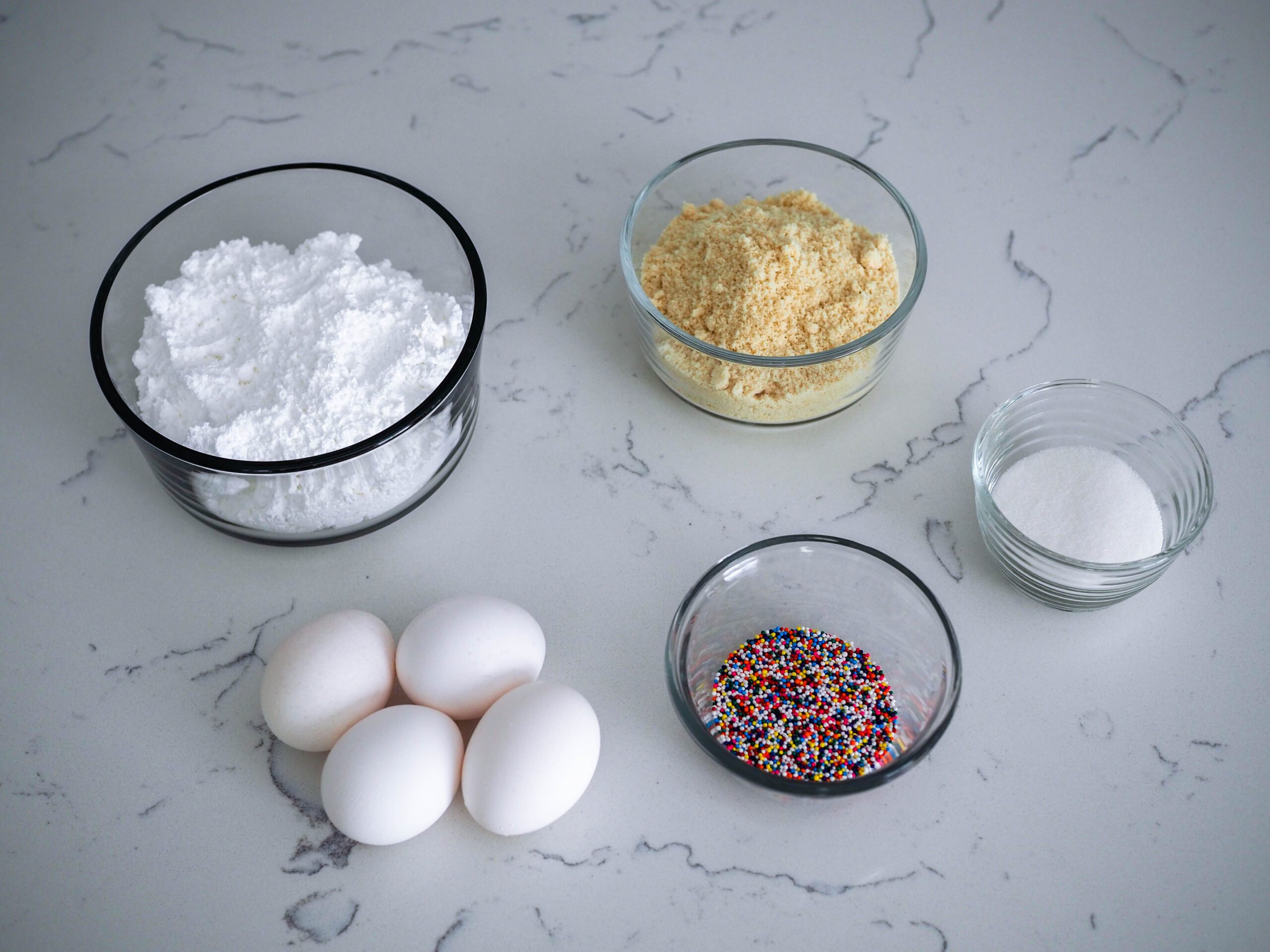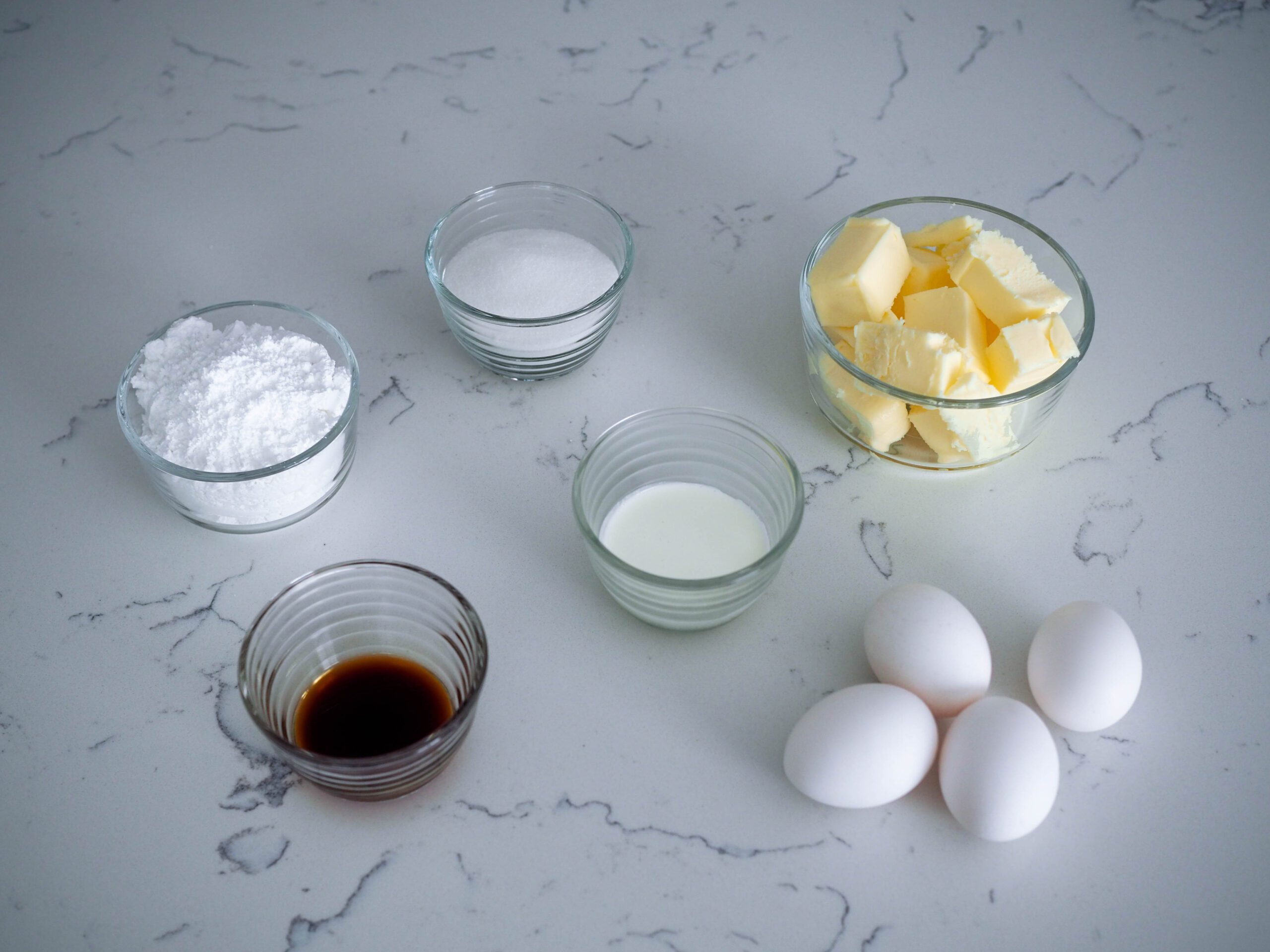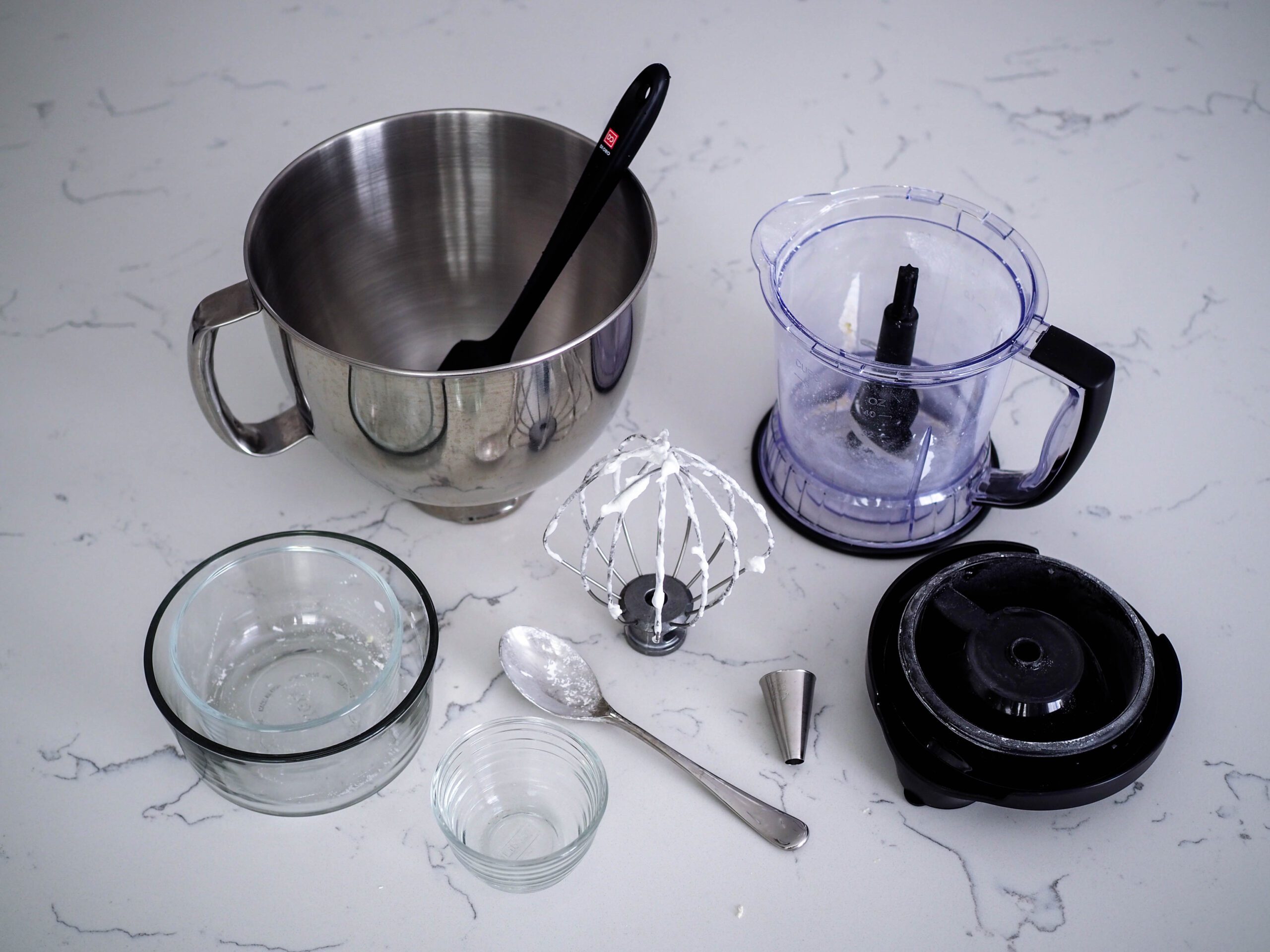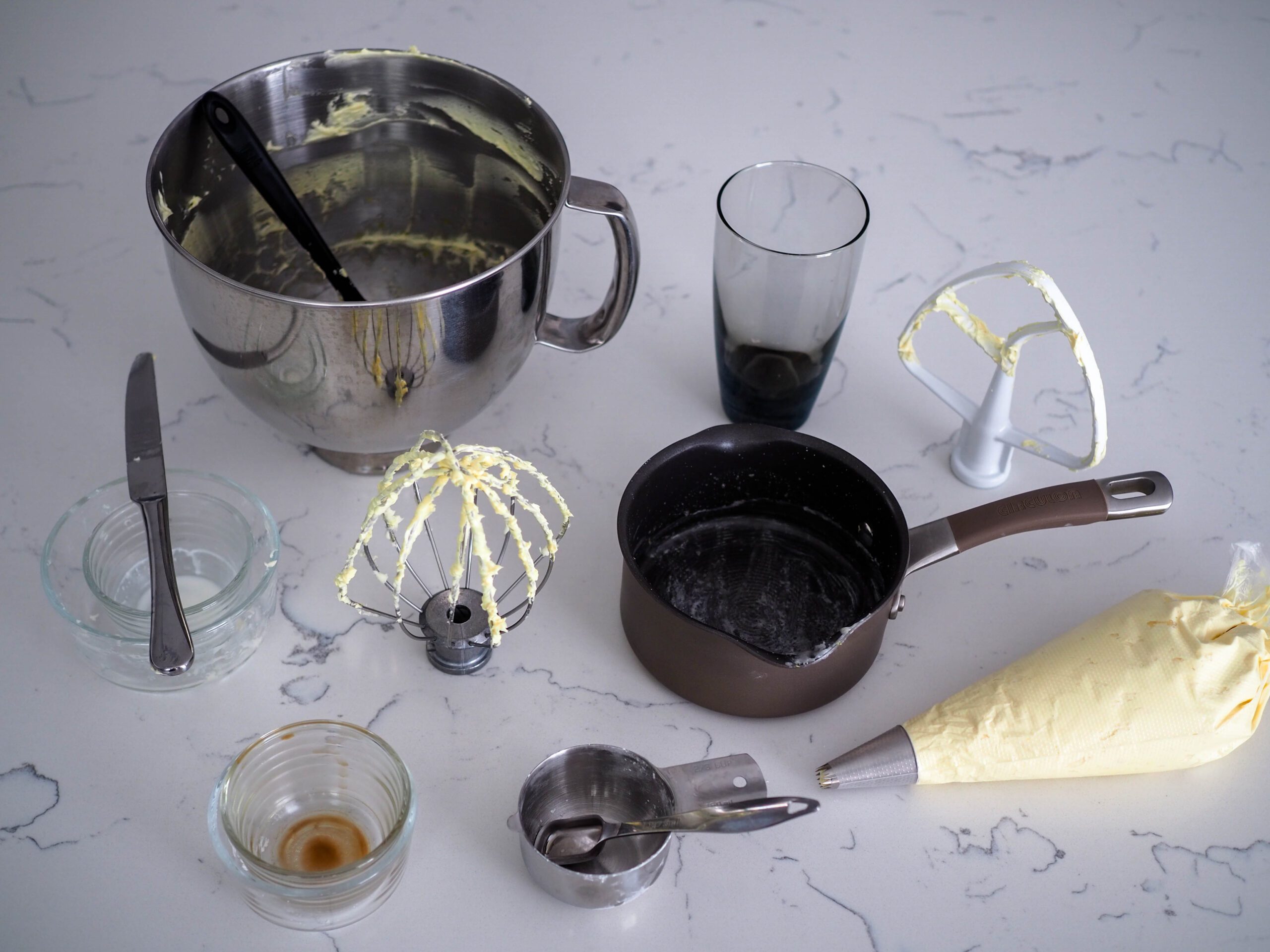A fancier alternative for Funfetti, these birthday cake macarons have a custardy French buttercream that tastes exactly like birthday cake batter. Top with some sprinkles for a delectable birthday dessert.
Are Macarons Hard to Make?
Yes and no. Macarons are notoriously finicky creatures, as there are a lot of variables that can change the outcome of your meringue cookie. It can take quite a few tries before you get a perfect batch of macarons.
The good news? Once you figure out the correct set of variables for your kitchen, macarons are one of the easiest recipes to make!
I’ve made macarons consistently (read: at least two batches a month [and usually closer to six]) for about 18 months now. I created a recipe that worked perfectly in our rental, and then we purchased a home a mile away that required a few tweaks to my original recipe. After an eight-month trial and error period figuring out the variables in our new home, I now have a 98% success rate for a “perfect” batch of macs using my own recipe.
If you’re new to making macarons and are nervous to start, I would recommend making my ladyfingers recipe first. The steps are similar to macarons but the batter is far more forgiving. It’s a great stepping stone that gets you familiar with the process of making macarons but without as much frustration.
Tips for Prepping French Macaron Shells
The most important thing to remember is that macarons are finicky. Even if they don’t look perfect, they’ll still taste great!
The number one tip I have for making French macaron shells is to be patient. Like I said above, it can take a number of tries to get a perfect batch. My first batch of macarons came out well enough, though there were a few cracked shells. It took me quite a few months, though, to feel confident that each batch I put in the oven would turn out.
Recommended Supplies for Making Macarons
Each oven and home variables vary. I can’t guarantee that these supplies will turn out perfect macs for you. I have used dark baking sheets and aluminum baking sheets and had success in different ovens. With my current oven, a light-colored aluminum baking sheet is essential for turning out macarons.
In my old house and old oven, I could use a dark nonstick pan and parchment paper on top of silicon macaron mats with no issues. In my new house and new oven, I have to use aluminum pans with silicon macaron mats (affiliate links).
If you are following all the steps and your macarons still aren’t consistent after five batches, I would look into your supplies. Try changing one variable at a time to determine what the problem is.
The Perfect Meringue Base
A good meringue is key for a good macaron. French macarons generally call for aged or at least room temperature egg whites—I can use eggs directly from the fridge without a stabilizer because of the way I mix up my meringue.
I adapted this technique from Cenk Sönmezsoy’s The Artful Baker (though he recommends room temperature egg whites). If you’re newer to meringue, I would recommend using room temperature egg whites, as they are a bit more elastic (read: forgiving).
For a perfect French meringue every time, start by whipping the egg whites on low in a stand mixer, just to incorporate. Once the whites begin to foam, increase the speed to medium. The whisk will begin to leave trails in the foam; at that point, sprinkle in the sugar about a teaspoon at a time.
When all the sugar is incorporated, increase the speed to high and whisk until you begin to see the whisk leave deep indents in the meringue (anywhere from three to five minutes).
Test to see if the meringue has stiff peaks by removing the whisk and flipping it upside down. If the meringue stands straight up or curls into itself lightly with a sharp point, stop whisking. (See photo below.) If the point is soft and looks like it has a lot of tiny bubbles in it, whisk for another 10 seconds, then test again.
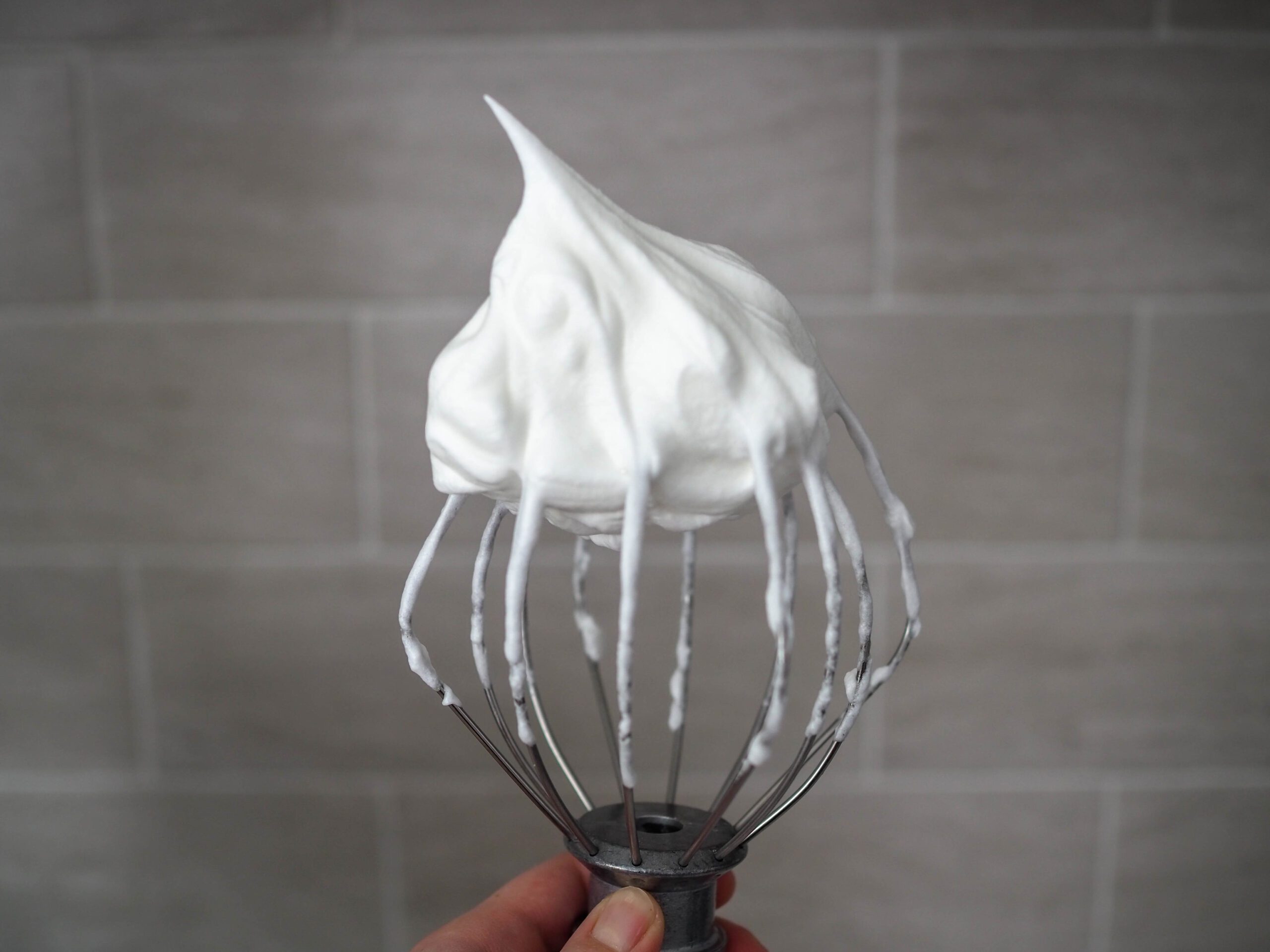
The Perfect Macaron Batter Consistency
Macaron batter needs to be a certain consistency in order to develop feet. The consistency and process is so important that it has its own name: “macaronage.”
The top descriptor I have read for testing macaron batter consistency is it “flows off the spatula like hot lava…” I have never seen hot lava in person, much less seen it being picked up with a spatula. That phrase does not personally help me figure out how to macaronage, which is one of the most important things for beginners to understand.
A more fitting description for the perfect macaron batter consistency is to think of macaronage as a process, not an end result.
Macaronage as a Process
The egg whites start out as liquid with no air in them. Then you whip in lots of very tiny air bubbles to transform the egg whites into a meringue. You have added so much air into the egg whites that now they essentially function as a solid instead of a liquid.
Then, you fold in almond flour and powdered sugar. As you fold the batter with a spatula, you are knocking the air out of the meringue. That helps to transform our previously solid meringue back into a liquid batter. The more folds you give the batter, the more liquid the batter becomes. (My husband says this is called viscosity, but that’s a bit technical.)
The perfect consistency of macaron batter will look grainy as it flows off the spatula in one long, stacking ribbon. Then, it begin to look shiny and absorb back into the rest of the batter within 10-15 seconds.
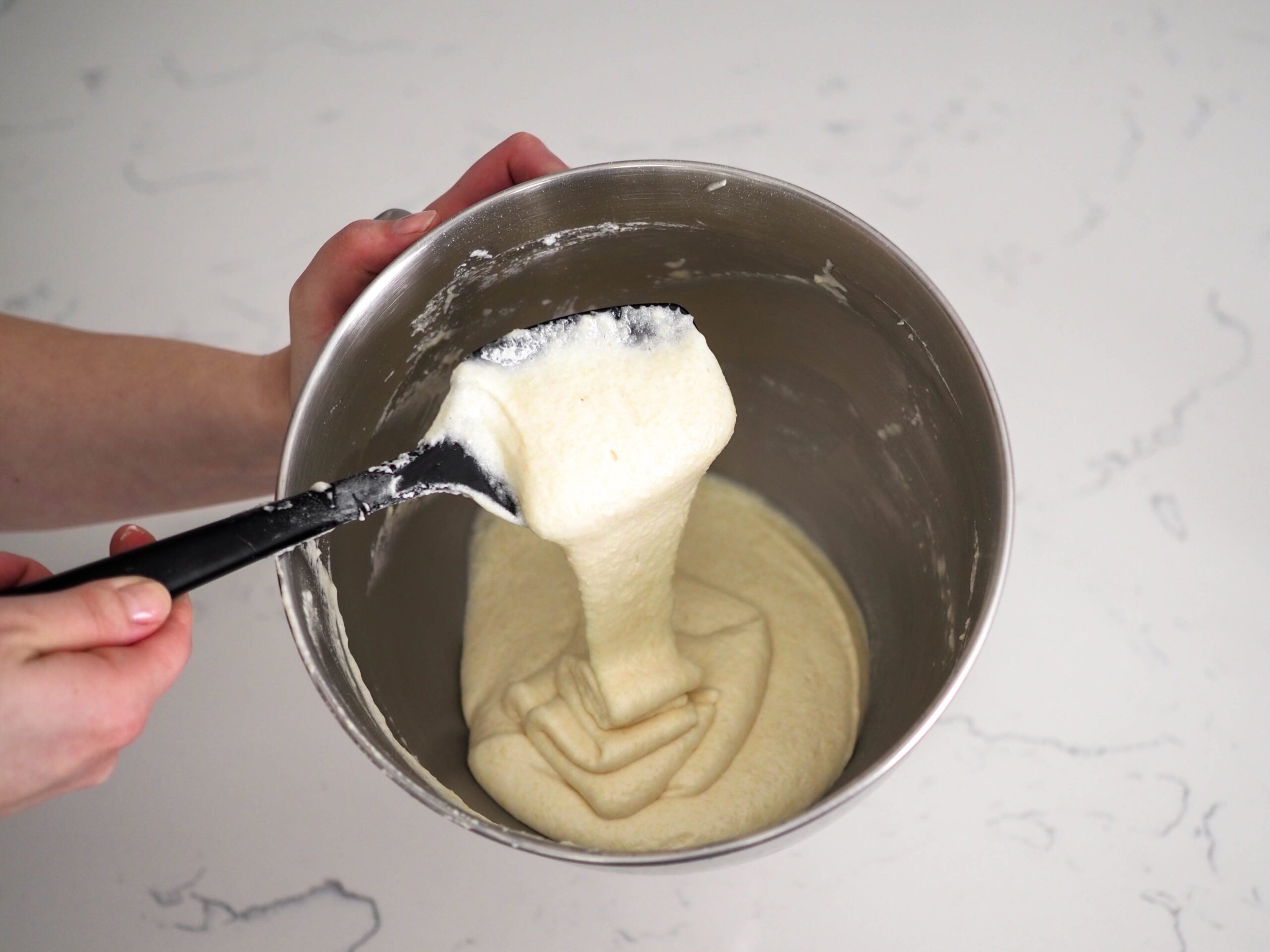
If your batter takes more than 15 seconds to absorb, you need to knock more air out of the meringue. If your batter takes closer to 5 seconds to absorb, it’s likely overmixed; however, it will probably still turn out decent macarons. Unfortunately, if your batter absorbs immediately, there is not enough air left in the meringue to form proper macarons. I recommend starting over.
My Tip to Prevent Wasting Egg Whites
My recipe for French macarons calls for 120 grams of egg whites, but I have never cracked open four eggs and gotten a perfect 120 grams. A little secret for you: I slightly adjust my recipe every time to accommodate the natural change in egg size.
If the egg whites I’m using weigh 127 grams, instead of trying to reduce the egg white by seven grams, I simply increase my almond flour by seven grams to account for it. This prevents me from wasting any egg white. It also prevents me from begrudgingly removing a teaspoon of egg white at a time trying to get the right weight.
Do I Really Need to Weigh the Ingredients for Macarons?
YES. If there was ever a case for all-caps, this is it. I typically include both volumetric (cups) and mass (weight) measurements on my recipes, but because macarons are so finicky, I have only included mass measurements. Yes, this requires a kitchen scale, but it is worth it to get perfect macarons every time.
Kitchen scales are relatively inexpensive as far as minor appliances go, and they will last you forever. I have this kitchen scale from OXO and love it (affiliate link).
Quick Tips for Prepping French Buttercream
French buttercream is made from a hot sugar syrup, egg yolks, and butter. The sugar syrup cooks the egg yolks somewhat, but if you’re wary of salmonella, you can always use pasteurized egg yolks.
Try your best to pour the sugar syrup onto the side of the stand mixer bowl so that it runs down into the egg yolks. If you pour the syrup onto the whisk, the sugar splatters and cools down before it gets to the yolks, which can result in a grainy buttercream.
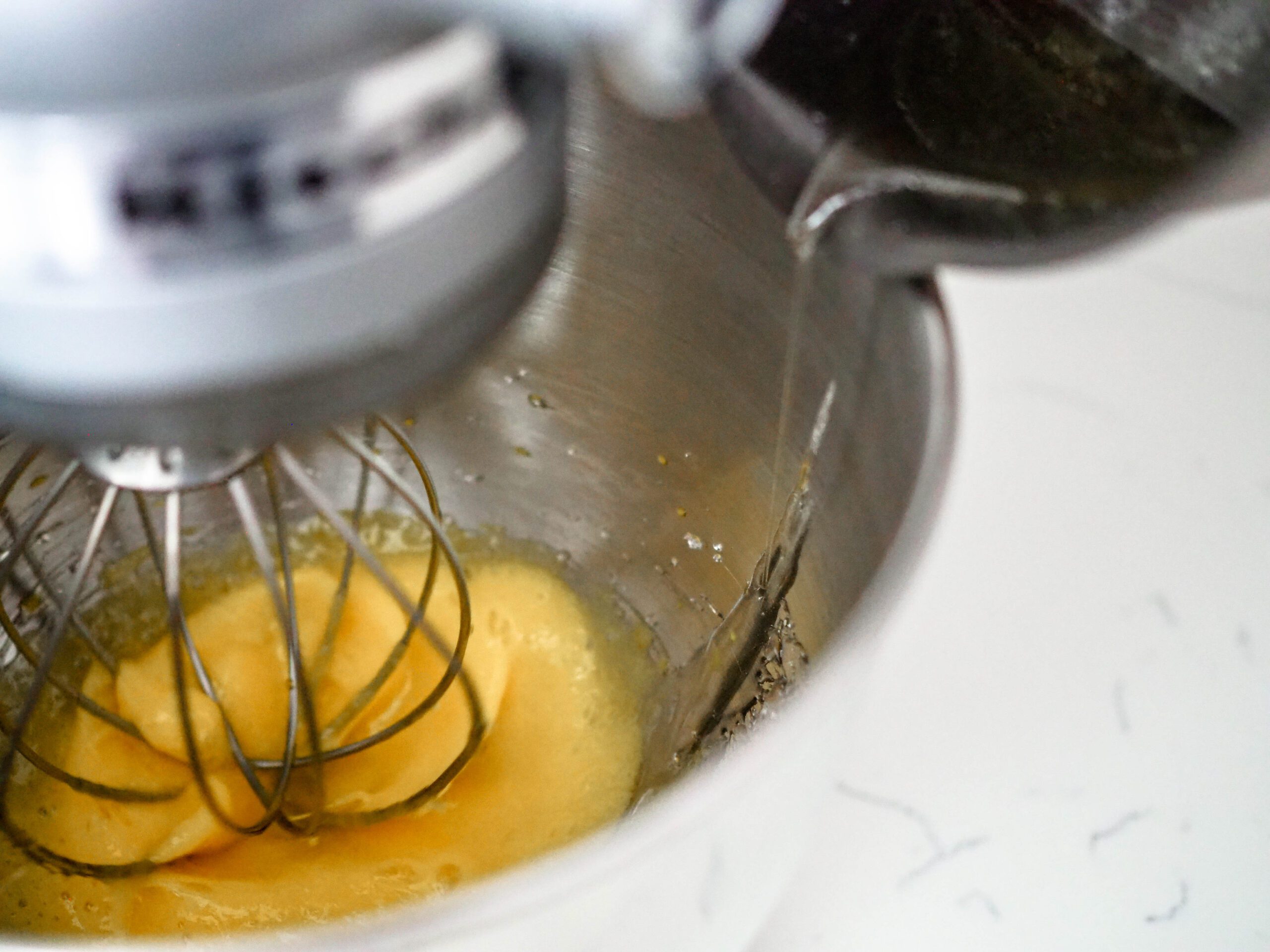
French buttercream is particular (much like its French macaron counterpart here). The buttercream may begin to curdle when you add in the butter piece by piece. If it starts to curdle before you’ve added all your butter, switch the attachment head from a whisk to a beater and beat it until it no longer looks curdled. Then finish adding in your butter.
While creating this recipe, I accidentally used salted butter instead of unsalted. I tried to offset the saltiness with heavy cream and powdered sugar (two ingredients that aren’t typically in French buttercream). The result was a custardy buttercream that tasted exactly like cake batter. For that reason, salted butter is recommended for this recipe.
Dish Cleanup: Gonna Take a While
I rate my recipe cleanups on a scale of 1 to 5. 1 is only a handful of dishes, and 5 is everything including the kitchen sink.
My birthday cake macarons recipe is a 4. Macaron shells don’t dirty too many dishes and neither does the buttercream. When combined, though, the resulting dishes are comparable to that of making a birthday cake entirely from scratch.
Birthday Cake Macarons

A delectable French macaron recipe with a custardy French buttercream that tastes exactly like birthday cake batter. Complete with sprinkles!
Ingredients
French Macaron Shells
- 120 g almond flour
- 200 g powdered sugar
- 120 g egg whites, from 3-4 large eggs
- 50 g granulated sugar
- ½ teaspoon vanilla extract (3 ml)
- 1 Tablespoon rainbow mini nonpareil sprinkles
Birthday Cake Batter French Buttercream
- 4 large egg yolks
- ½ cup granulated sugar (100 g)
- 3 Tablespoons water (45 ml)
- 1 cup salted butter (226 g)
- 1 Tablespoon vanilla extract (15 ml)
- ½ cup powdered sugar (55 g)
- 2 Tablespoons heavy cream (30 ml)
Instructions
Making the Macarons
- Prepare two baking sheets with macaron silpats or parchment paper. Prepare a piping bag fitted with a round tip (like Wilton #12) and set aside.
- Process powdered sugar and almond flour together in a food processor or blender for a superfine consistency. This is necessary for perfectly smooth shells. Set aside.
- Separate the eggs (save the yolks for your buttercream!). Place egg whites in the bowl of a stand mixer fitted with the whisk attachment and mix on low until frothy. Increase speed to medium. Once the whisk begins leaving a trail, sprinkle in the sugar about a teaspoon at a time. Once all the sugar is incorporated, increase speed to high and whisk until stiff peaks form. Add in vanilla extract and gel food coloring if desired. Whisk on medium high for just a couple of seconds to fully incorporate.
- Remove the bowl from the stand mixer and pour half of the almond flour mixture into the meringue. Fold together until fully incorporated, scraping the sides and bottom of the bowl. Add in the remaining almond flour mixture and fold together. The mixture will be thick, but as you continue folding, it will lose some air and thin out. Continue folding and pressing the batter into the sides of the bowl until the batter is the correct consistency (covered in the next step).
- To test the consistency, scoop the batter up, and let it flow back into the bowl. Continue folding until the mixture flows in one solid ribbon off the spatula. It should look a bit grainy as it flows off the spatula, then dissolve back into the batter in about 15 seconds and look glossy instead of grainy.
- Pour the batter into the prepared piping bag. Holding the bag at a 90° angle to the pan, gently squeeze out the macaron batter into lumps about 1-1.5" in diameter. They will spread as they settle.
- Once piped, rap the baking sheets against the counter five times or until you see air bubbles rise from the bottoms of the shells. Use a toothpick to pop any remaining bubbles for a perfectly smooth top.
- Sprinkle the sprinkles on top of the macarons. I hold a pinch of sprinkles with my thumb, index finger, and middle finger and rub my fingers together to get them to fall evenly. It's okay if not all of the sprinkles stick to the tops of the macarons.
- Set the macarons aside in a well-ventilated area to dry for about 20-30 minutes. On particularly humid days, this may take about an hour; you can point a fan on low to speed up the process. While the macarons are drying, preheat the oven to 320°F. The macarons are ready to go in the oven when you can lightly touch the top of a macaron without it leaving residue on your finger.
Baking the Macarons
- Once the macarons are dry, bake one tray at a time in the center rack for 16-19 minutes or until the macaron is set. Test to see if the macarons are set: Try to gently wiggle a macaron back and forth from the center of the pan with your thumb and forefinger. If the center moves at all, put the tray back in the oven for another minute or two until the center of the macaron is set and does not move when prompted.
- Let each tray cool completely before removing the macarons from the mats, about 10 minutes.
Making the Buttercream
- While the macarons are baking, place four egg yolks in the bowl of a stand mixer and whisk together on low.
- Combine sugar and water in a small saucepan and heat over medium heat until the syrup reaches 245°F or 118°C (firm ball stage).
- With the stand mixer whisking on medium low, carefully pour the syrup inside the bowl, staying in one spot just outside of reach of the whisk. Try not to get syrup on the tines of the whisk, as the syrup will splatter and cool down before incorporating into the yolks.
- Once all the syrup has been poured in, increase the speed on the stand mixer to medium high and whisk the yolk mixture until the bowl no longer feels warm to the touch and the yolk mixture is pale yellow and fluffy. I like to cut my butter into 1" cubes while I'm waiting.
- When the mixture has cooled, begin incorporating the salted butter into the mix, one piece at a time. The buttercream may begin to look like it's curdling or separate at this point—if that happens, switch to a beater attachment. Once all the butter has been added, add the vanilla extract and switch the whisk to a beater attachment.
- Add in powdered sugar and heavy cream, then beat for two minutes to get the buttercream fluffy.
- Transfer into a piping bag prepared with the piping tip of your choice. (I used Ateco 864.)
Assembling the Macarons
- Pair similarly sized macarons together and line them up with one side face up and one side face down.
- On a macaron shell with the flat bottom facing up, pipe a dollop of buttercream about 2/3 the size of the macaron shell. Repeat with the rest of the macarons. Place the other macaron shell on top and twist while pressing lightly to form a nice seal. (You'll have about half of the buttercream leftover.)
- The macaron shells will soften and the flavors will develop after maturing in the fridge for one day, though you may eat them any time you'd prefer after assembly.
Notes
Store in the fridge in an airtight container for up to a week for maximum freshness.
This recipe makes enough buttercream for TWO batches of macarons but is difficult to make halved. If you can't find another use for the buttercream in a couple of days, I recommend freezing it for up to six months. Then thaw overnight in the fridge, bring to room temp, and rewhip before using in another recipe.
Nutrition Information:
Yield:
30Serving Size:
1 filled macaronAmount Per Serving: Calories: 156Total Fat: 10gSaturated Fat: 5gTrans Fat: 0gUnsaturated Fat: 5gCholesterol: 67mgSodium: 67mgCarbohydrates: 15gFiber: 1gSugar: 14gProtein: 3g
The nutrition facts are estimated and may vary based on specific ingredients used.
Thanks for trying out my birthday cake macarons recipe! I’d love to see how it turns out: Take a photo and tag me on Instagram @floralapronblog to share with me, or use the hashtag #floralapronbakes.
Other Recipes You May Enjoy
There are more macaron flavors available on the Macaron page here on my blog.
As I mentioned above, my ladyfingers recipe is a great place to start if you’ve never made macarons. The light, bite-sized sponge cakes are great to have on hand for trifles and no-bake desserts.
And if making macarons has overwhelmed you for a day, my no-bake protein granola bars are a great pick-me-up to keep in the fridge.

